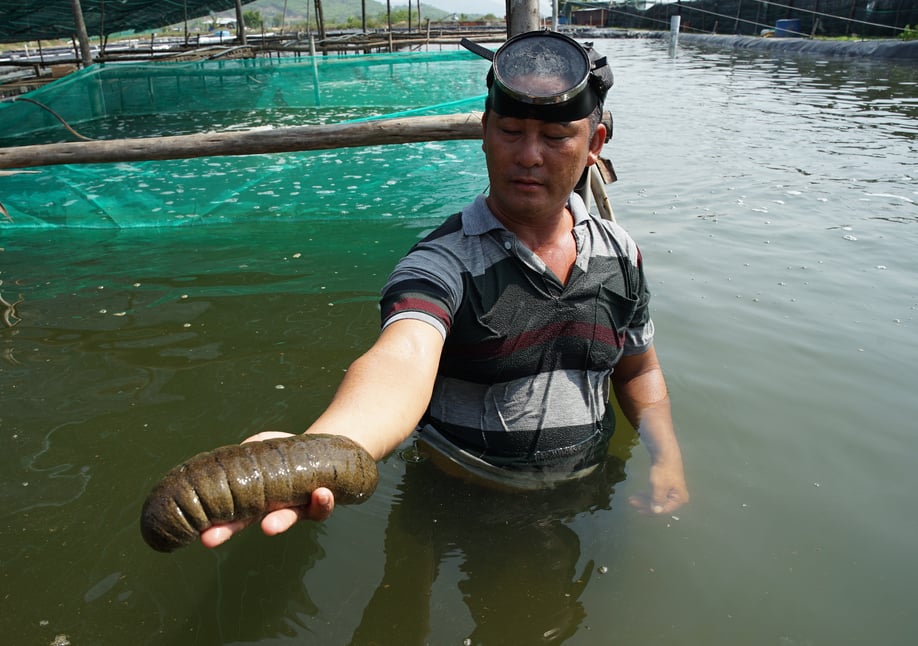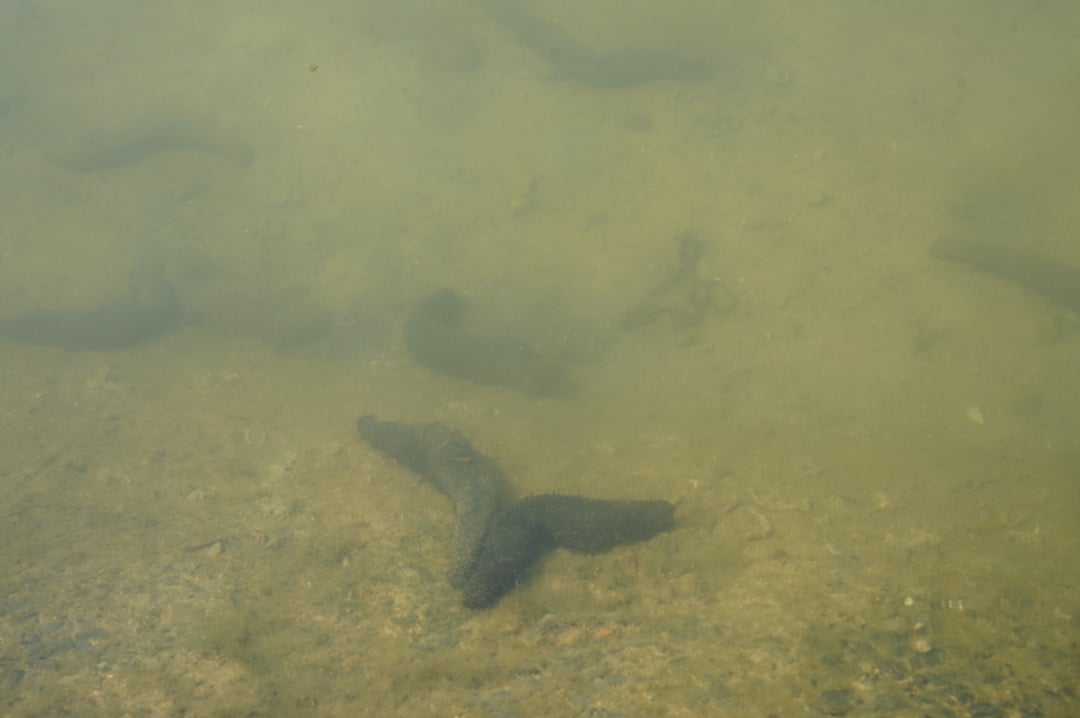May 21, 2025 | 06:28 GMT +7
May 21, 2025 | 06:28 GMT +7
Hotline: 0913.378.918
May 21, 2025 | 06:28 GMT +7
Hotline: 0913.378.918
There are 1,400 species of sea cucumbers in the world, but only 40 are edible, the most valuable of which is the sandfish. Sandfish, or Holothuria scabra, was once abundant in nature; however, it has been overfished and is now rare. Several species of sea cucumbers facing extinction or threatened with extinction are listed in the Vietnamese Red Book (2003).

Sandfish is the item with the highest nutritional value among sea cucumbers. Photo: Linh Linh.
In accordance with the current trend toward circular agricultural production, sea cucumber farming has only emerged commercially within the past few years, providing farmers with a source of income while also limiting the depletion of this marine resource and contributing to environmental protection.
Research Institute for Aquaculture 3 (RIA 3) has conducted research on sea cucumber seedling production technology and process in Vietnam through two ministerial-level projects: "Researching and perfecting the technological process of producing sandfish seeds in Nha Trang - Khanh Hoa" (2003-2004) and "Research on developing a process for commercial farming of sandfish on a production scale in ponds in some South Central coastal areas" (2008-2009).
In addition, Dr. Nguyen Dinh Quang Duy, an expert on sea cucumbers from RIA 3, has collaborated with Sunshine Coast University (Australia) during 2018-2023 to implement the project on "Increasing technical skills supporting community-based sea cucumber production in Vietnam and the Philippines" under the auspices of the Australian Center for International Agricultural Research (ACIAR).

The best sandfish farming environment with stable salinity, temperature from 22-35 degrees Celsius, bottom material is sand, sandy mud, and pH from 6.5 to 8.5. Photo: Linh Linh.
These projects and research have resulted in a new economic development orientation for sea cucumber farming in many regions of the country, as well as improved farming techniques to guarantee aquaculture quality and increase sea cucumber production capacity.
Dr. Nguyen Dinh Quang Duy disclosed that RIA 3 had mastered sandfish seed production technology and large-scale commercial aquaculture. In 2019, RIA 3 continued its fruitful research on white teatfish, or Holothuria fuscogilva, for seed production and commercial aquaculture.
The National Breeding Center for Southern Marine Aquaculture has allocated 4 hectares of the approximately 40-hectare aquaculture nursery area to experiment with and cultivate three varieties of sea cucumbers (black sea cucumber, sandfish, and white teatfish). The area is divided into numerous interior and outdoor sections suited for each stage of the sea cucumber's development.

Dr. Nguyen Dinh Quang Duy has joined ACIAR, partner agencies, and scientists in many research projects on sea cucumbers. Photo: Linh Linh.
According to Dr. Duy, newly formed larvae are extremely light-sensitive, so they must be incubated for three to four weeks on suitable plates (about 500 larvae per plate) in interior tanks before being transferred to the outdoor pond to develop as seeds. The most challenging phases of sea cucumber cultivation are fertilization and larval development; these two stages require the most technological intervention.
In an agricultural environment, the parent sea cucumbers are stimulated and nourished for three to four years in order to produce seeds. This is also a strength of sea cucumber aquaculture, the ACIAR project to breed sandfish with snails and pomfrets, with a rearing period of eight to ten months and a profit rate of over 70 percent.

Larvae live on plastic sheets in an artificial culture environment to develop into seeds. Photo: Linh Linh.
"Output is the key to stabilizing agriculture, and this is also a concern when beginning to cultivate a new species. Currently, enterprises and farmers share a particular link. Mr. Duy explained that the role of RIA 3 and researchers is to complete the technical stages and recommend to farmers that they modify their processes and product quality.

Seeds are farmed in outdoor tanks after 3 weeks - 1 month of indoor incubation. Photo: Linh Linh.
The Center is capable of producing approximately 2.5 million seedlings per year and has expansion plans, but it needs to first determine the necessary seed quantity and quality. Vietnam, according to the representative of RIA 3, is presently one of the most successful countries in the commercial production of sea cucumber seeds and products, both in terms of scientific and commercial renown. Dr. Nguyen Dinh Quang Duy desires to develop the model into a Vietnam sea cucumber incubation center in the South Central region, given the current positive results.
Do Phuoc Kha, head of the Material Area Development Department at Vietnam Sea Cucumber Company, stated that the pricing of the company's preliminarily processed products was 200,000 VND per kilogram. The company also inked a contract to underwrite products and provide seeds to ensure benefits.

Sea cucumber farming area at the National Breeding Center for Southern Marine Aquaculture, RIA 3. Photo: Linh Linh.
According to Kha, the Van Ninh and Khanh Hoa regions produce 8 tons of sea cucumbers annually. Nonetheless, this quantity is still below the market demand.
This year, the corporation intends to purchase three million commercial sea cucumbers, a 200 percent increase from the previous year. In the future years, the volume of purchases will increase to between 6 and 9 million sea cucumbers, according to Mr. Kha.
In order to increase the value of sea cucumbers, the company will focus on constructing a facility for processing collagen, capsules, and functional foods, as well as conducting in-depth research on the primary product.
Mr. Nguyen Huu Ninh, Deputy Director of the Department of Science, Technology, and Environment (MARD), opined that environmental and social concerns are two aspects of sustainable development that must be accounted for. According to his analysis, the majority of ACIAR-funded initiatives are geared toward improving people's livelihoods. In terms of environmental sustainability, the project's objects also serve to safeguard the natural environment, such as the penguin's wing oyster, sea cucumbers, etc., which are capable of filtering and cleaning the natural environment. These subjects do not necessitate significant investment or sustenance, nor are they laborious, yet the economic returns are substantial.
"I believe that similar subjects should also be explored. It is prudent to select an object that genuinely promotes economic efficiency, but it must also guarantee environmental sustainability and provide livelihoods for people.", Mr. Ninh shared.
Translated by Dieu Linh

(VAN) Japan's grant aid project contributes to capacity building, promoting organic agricultural production, and fostering sustainable community development in Dong Thap province.

(VAN) For years, the CRISPR-Cas9 genome technology has been reshaping genetic engineering, a precision tool to transform everything from agriculture to medicine.

(VAN) Vietnam aims to become a 'leader' in the region in the capacity and managing effectively soil health and crop nutrition.
![Reducing emissions from rice fields: [Part 1] Farming clean rice together](https://t.ex-cdn.com/nongnghiepmoitruong.vn/608w/files/news/2025/05/05/z6509661417740_a647202949c539012a959e841c03e1d3-nongnghiep-143611.jpg)
(VAN) Growing clean rice helps reduce environmental pollution while increasing income, allowing farmers to feel secure in production and remain committed to their fields for the long term.
/2025/05/19/5136-1-144800_230.jpg)
(VAN) The Nghe An Provincial People's Committee has just approved the list of beneficiaries eligible for revenue from the Emission Reductions Payment Agreement (ERPA) in the North Central region for the year 2025.

(VAN) 14 out of 35 domesticated elephants in Dak Lak province have had their living conditions improved, with 11 of them currently participating in the non-riding elephant tourism model.

(VAN) Muong Nhe Nature Reserve hopes that being upgraded to a national park will lay the foundation for forest protection efforts to be carried out in a systematic, modern, and sustainable manner.